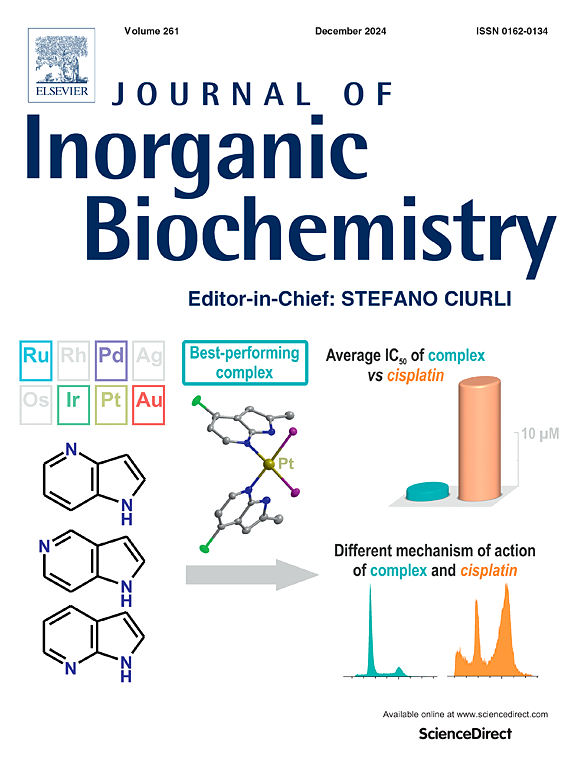DNA cleavage and antitumoral activity of zinc(II) and iron(III) complexes with a new phenol-based ligand containing uncoordinated thioether moieties
IF 3.2
2区 化学
Q2 BIOCHEMISTRY & MOLECULAR BIOLOGY
引用次数: 0
Abstract
In this study, a novel ligand: 2-((bis(2-(phenylthio)ethyl)amino)methyl)-6-((bis(pyridin-2-ylmethyl)amino)methyl)-4-methylphenol (HL) was prepared and subsequently used to synthesize the complexes [Zn(L)(OAc)]ClO4 (1) and [Fe2(L)(μ-OAc)(μ-O)](ClO4)2 (2). The metal complexes were comprehensively characterized using different techniques such as IR, Mass Spectrometry, UV–Vis, elemental analysis and X-ray analysis. The crystal structures show that compound 1 is a mononuclear pentacoordinate zinc(II) complex, while compound 2 is a dinuclear hexacoordinate iron(III) compound, with the metal centers connected by μ-oxo and μ-acetato bridges. In both cases, the phenol-based ligand features thioether substituents as pendant arms. We have evaluated the binding of the new complexes to DNA and also their capacity to cleave it. Both complexes have excellent antitumor activity against an astrocytic tumor derived from a primary human GBM1 cell line.
Synopsis
The paper reports synthesis and characterization of two new complexes [Zn(L)(OAc)]ClO4 (1) and [Fe2(L)(μ-OAc)(μ-O)](ClO4)2 (2). Complex 1 exhibits better activity than 2 at lower concentrations and with a faster rate of action, showing a preference for the minor groove. The cytotoxicity studies demonstrated a reduction in cell viability when exposed to the complexes, with GBM and C6 cells.

含不配位硫醚基团的新型酚基配体对锌(II)和铁(III)的DNA切割和抗肿瘤活性的影响
本研究制备了一种新型配体:2-((双(2-(苯基硫)乙基)氨基)甲基)-6-((双(吡啶-2-甲基)氨基)甲基)-4-甲基苯酚(HL),并用于合成配合物[Zn(L)(OAc)]ClO4(1)和[Fe2(L)(μ-OAc)(μ-O)](ClO4)2(2)。利用红外光谱、质谱、紫外-可见、元素分析和x射线分析等技术对金属配合物进行了综合表征。晶体结构表明,化合物1为单核五配位锌(II)配合物,化合物2为双核六配位铁(III)配合物,金属中心由μ-氧和μ-乙酰桥连接。在这两种情况下,酚基配体的特征是硫醚取代基作为垂臂。我们已经评估了新复合物与DNA的结合以及它们切割DNA的能力。这两种复合物对源自人原代GBM1细胞系的星形细胞肿瘤具有良好的抗肿瘤活性。本文报道了两种新型配合物[Zn(L)(OAc)]ClO4(1)和[Fe2(L)(μ-OAc)(μ-O)](ClO4)2(2)的合成和表征。配合物1在较低的浓度和较快的作用速率下比2表现出较好的活性,表现出对小凹槽的偏爱。细胞毒性研究表明,当暴露于GBM和C6细胞的复合物时,细胞活力降低。
本文章由计算机程序翻译,如有差异,请以英文原文为准。
求助全文
约1分钟内获得全文
求助全文
来源期刊

Journal of Inorganic Biochemistry
生物-生化与分子生物学
CiteScore
7.00
自引率
10.30%
发文量
336
审稿时长
41 days
期刊介绍:
The Journal of Inorganic Biochemistry is an established international forum for research in all aspects of Biological Inorganic Chemistry. Original papers of a high scientific level are published in the form of Articles (full length papers), Short Communications, Focused Reviews and Bioinorganic Methods. Topics include: the chemistry, structure and function of metalloenzymes; the interaction of inorganic ions and molecules with proteins and nucleic acids; the synthesis and properties of coordination complexes of biological interest including both structural and functional model systems; the function of metal- containing systems in the regulation of gene expression; the role of metals in medicine; the application of spectroscopic methods to determine the structure of metallobiomolecules; the preparation and characterization of metal-based biomaterials; and related systems. The emphasis of the Journal is on the structure and mechanism of action of metallobiomolecules.
 求助内容:
求助内容: 应助结果提醒方式:
应助结果提醒方式:


